Yokohama Museum of Art Collection December 9, 2017- March 4, 2018
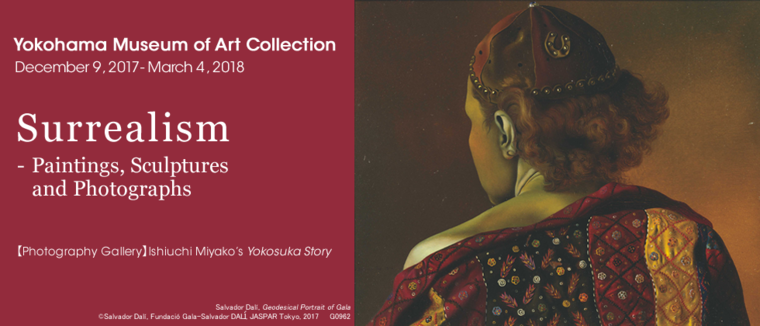
Salvador Dalí, "Geodesical Portrait of Gala,” 1936, tempera on wood, 21.0×27.0㎝
©Salvador Dalí, Fundació Gala-Salvador Dalí, JASPAR Tokyo, 2017 G0962
Highlight
Surrealism - Paintings, Sculptures and Photographs
1. Skill Not Required
2. Groping Toward Landscape
3. Another Kind of Found Landscape
4. Found the Object I Was Looking For
5. Goddesses, Monsters, Or...?
6. What Part of Me Is It That You...?
7. Grown-Ups at Play With Dolls
8. Approaches to Homage
9. Methods of Transcending Death
10. Encounters Between Word and Image
11. Is Surrealism a Style?
[Photography Gallery]Ishiuchi Miyako’s "Yokosuka Story"
In 1983, prior to the opening of the Yokohama Museum of Art, the facility began collecting Surrealist art works. Made up of multiple pieces by central Surrealist figures such as René Magritte, Paul Delvaux, Salvador Dalí, Man Ray, Max Ernst, Hans (Jean) Arp, Joan Miró, and André Masson, the collection conveys the artists’ diverse range of activities, and their efforts to forge into many different genres, including not only oil painting but also collage, sculpture, printmaking, and photography.
The works also represent the expansive view of Surrealism, which transcended national and ethnic boundaries by encompassing artists from all over the world such as Roberto Matta (Chile), Óscar Domínguez (Canary Islands), Wilfredo Lam (Cuba), and John Armstrong (U.K.). In addition, the collection contains a rich array of photographs by Man Ray, Hans Bellmer, Jindřich Štyrský, Wols, and others.
In this edition of the collection exhibition, making full use of three galleries, viewers will be treated to a virtually complete group of Surrealist works from the museum’s holdings – the first time such an exhibition has ever been attempted at the museum.
In conjunction with the "Ishiuchi Miyako: Grain and Image" exhibition, we also present Ishiuchi’s "Yokosuka Story" and other works by the artist from the museum collection in the Photography Gallery.
List of works [1.17MB]
Sections
1. Skill Not Required
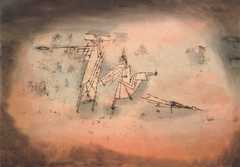
Paul KLEE
“Des Angriffs Materie, Geist und Symbol”
1922
watercolor and oil on paper
33.3×47.5cm
When we try to draw “skillfully,” we tamp down the autonomous action of inspiration, and the Surrealists regarded the resulting art as a fabrication. They referred to this autonomous action as “automatism,” and developed methods that anyone could practice in order to activate it. These included cutting and pasting pre-existing images to make collages, making rubbings of everyday surfaces in the surrounding environment (frottage), basing paintings around the accidental shapes of paint stains (decalcomania), and placing objects directly on photographic paper and exposing it (photograms).
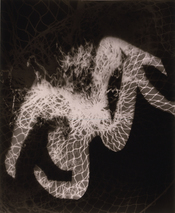
EI-KYU
From “Photo-dessin: Raison du sommeil, par Q. EI”
1936
gelatin silver print
26.1×21.5cm
2. Groping Toward Landscape
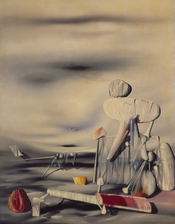
Yves TANGUY
“L’Alphabet du vent”
1944
oil on canvas
100.0×81.0cm
3. Another Kind of Found Landscape
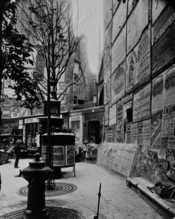
Eugène ATGET
“Coin de la rue Saint-Jacques, 5e”
1899 (printed in 1977)
gelatin silver print
22.0×17.4cm
Eugène Atget, a photographer active at the beginning of the 20th century, vividly documented anonymous streets, shops, parks and other deserted corners of old Paris with a large-format box camera, and sold the photographs as reference material for painters and stage set designers. Atget’s photographs, compellingly presenting the stark face of the city, along with precise shooting location information, had a major influence on Man Ray, Berenice Abbott, and other Surrealists and photographers. Through them, Atget became a well-known name.
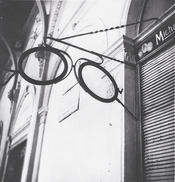
Jindřich ŠTYRSKÝ
From “On the Needle of These Days”
ca.1934
gelatin silver print
9.4×9.0cm
The works in this section depict enigmatic scenes, but perhaps we can view them as showing moments when the outer and inner worlds overlap.
4. Found the Object I Was Looking For
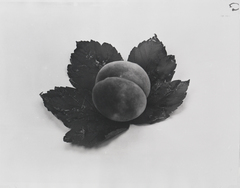
Man RAY
“Péche et feuille”
1931 (printed later)
gelatin silver print
22.6×30.1cm
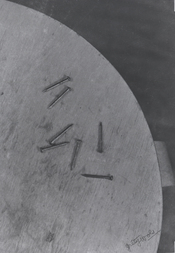
WOLS
Untitled
1939 (printed in 1979)
gelatin silver print
30.5×21.3cm
5. Goddesses, Monsters, Or...?
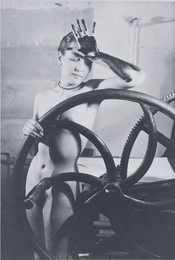
Man RAY
“Meret Oppenheim”
1933 (printed later)
gelatin silver print
37.7×25.4cm
Man Ray lauded Meret Oppenheim, one of the few female Surrealist artists, who also actively posed for photographs by Man Ray and others, viewing her as a muse who brought artists spiritual inspiration. Pablo Picasso depicted women in various ways, including as a guide leading the lost Minotaur with light, but also exploring aspects of men’s fear of women such as emasculation. André Masson depicted the mythical character of Penthesilea as a cannibal devouring her lover Achilles, while Hans Bellmer presented the sadistically bound female body, highlighting modes of interaction between actual women’s internal lives and the objectifying outside world. In this section we focus on images of women in Surrealist art, including works dealing with female homosexuality and cross-dressing.
6. What Part of Me Is It That You...?
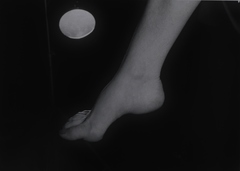
WOLS
Untitled
1938 (printed in 1979)
gelatin silver print
22.0×30.7cm
Works by Man Ray, André Kertész, and Umbo (Otto Umbehr) focusing on the eyes disrupt our sense of seeing vs. being seen. Another perspective that Surrealism introduced was attention to parts of the body less noticed in everyday life: Jacques-André Boiffard depicted the thumb and soles of the feet. Wols combined landscapes with legs. Hans Bellmer focused on the buttocks. In these photographs, we see the endeavors of artists to open up new relationships between human beings’ inner and outer worlds by showcasing the body, so seemingly obvious that is often overlooked, as an unknown “foreign object.”
7. Grown-Ups at Play With Dolls
Among works of Surrealist art are those featuring dolls of various kinds, including mannequins, ball-jointed dolls, toys, and dolls made by hand. As something that seems to be constantly traversing the boundary between inanimate object and living thing, dolls are imbued with a transfixing power.
The living women and a mannequin in Paul Delvaux’s painting “L’Escalier” (Stairs) are similarly dressed in lace. “Les Derniers beaux jours,” illustrating the story of a man who taxidermies his dead wife, builds on the myth of Pygmalion, who falls in love with a statue he made, prays to the gods that she will become a living human being, and marries her. In works by Giorgio de Chirico and Max Ernst, mannequins replace human beings as the protagonists. Hans Bellmer created a life-sized jointed doll of a girl, deconstructed and reconstructed it, and photographed it in various indoor and outdoor settings, creating a dense world that could be called mythical. In these works we can see an inner human realm that can only be rendered visible through dolls.
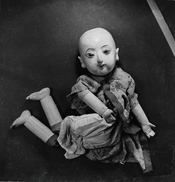
WOLS
Untitled
1933 (printed in 1979)
gelatin silver print
24.7×24.0cm
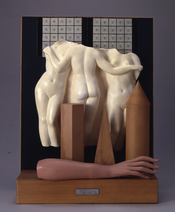
Man RAY
“Target”
1933 (reproduced in 1971)
mixed media
66.0×50.5×24.0cm
ⓒ MAN RAY TRUST / ADAGP, Paris & JASPAR, Tokyo, 2017 C1768
8. Approaches to Homage
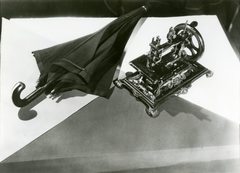
Man RAY
“Beau comme la rencontre fortuite sur une table de dissection d’une machine à coudre et d’un parapluie”
ca.1935 (printed later)
gelatin silver print
20.2×27.9cm
Man Ray’s photograph is in fact a straightforward homage, giving visible form to a quotation from the poet the Comte de Lautréamont of great importance to the Surrealists: “Beautiful as the chance meeting on a dissecting-table of a sewing-machine and an umbrella.” By contrast “Fantastic Landscapes,” which heroically presented the emergence, success, and old age of patron Helena Rubinstein in three stages of a day, is an example of a highly complex approach. In the idealized figure of this businesswoman who built a huge fortune, Salvador Dalí delivered a sarcastic counterattack against his former ally André Breton, who had criticized Dalí by nicknaming him “Avida Dollars” (an anagram of “Salvador Dalí” meaning “eager for dollars”), by incorporating an alchemical text illustration that Breton greatly valued.
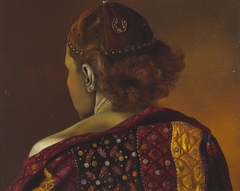
Salvador DALÍ
“Portrait géodésique de Gala”
1936
tempera on panel
21.0×27.0cm
ⓒ Salvador Dalí, Fundació Gala-Salvador Dalí, JASPAR Tokyo, 2017 G0962
9. Methods of Transcending Death
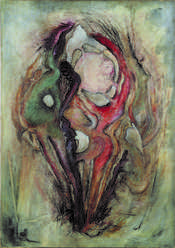
WOLS
“Végétal”
1947
oil on canvas
92.0×65.0cm
Works by Man Ray and Wols feature subjects such as eggs and embryos that contain the beginnings of life. Hans (Jean) Arp produced many powerful images of writhing, formless creation. Wifredo Lam superimposed symbols of folk beliefs from his own Afro-Cuban background and the I Ching to the story of Adam and Eve motifs, opening the ancient Biblical narrative – of original sin and human beings’ destiny to suffer in birth, life, and death – to more universal images of the conflict and union of the yin (female) and yang (male) principles. In André Masson’s work depicting Narcissus and Echo, who died of love gone mad, the “transformation” of the heroes into flowers and forest spirits is a one major motif.
10. Encounters Between Word and Image
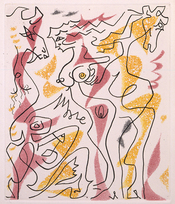
André MASSON
Illustration for “René Crevel ‘Feuilles eparsés’”
published in 1965 (Louis Broder, Paris)
etching and aquatint
20.6×17.2cm
ⓒ ADAGP, Paris & JASPAR Tokyo, 2017 C1768
Here we present works where, as in Magritte’s words, the title of a painting does not “explain” it, or illustrations do not merely “show scenes from” poetry and stories. We hope that the encounters the Surrealists present will resonate with each viewer’s own internal images and expand into deep dialogues that cannot be contained within a single interpretation.
11. Is Surrealism a Style?
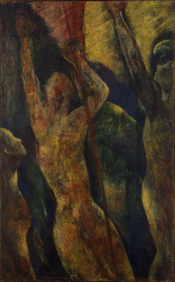
KAWAGUCHI Kigai
“A Group”
1941
oil on canvas
116.7×73.0cm
donated by Mr. Kawaguchi Kyoson
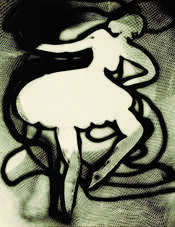
EI-KYU
“Ballerina”
ca.1950
gelatin silver print
27.8×21.6cm
[Photography Gallery] Ishiuchi Miyako’s “Yokosuka Story”
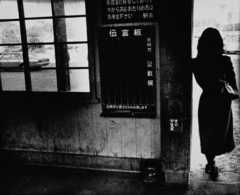
ISHIUCHI Miyako
“Yokosuka Story #58”
1976-77
gelatin silver print
45.5×55.8cm
ⓒ Ishiuchi Miyako
The “Yokosuka Story” series was Ishiuchi’s debut work and the point of departure for a photographic practice that continues to this day. Yokosuka is the city where she lived from the age of six to nineteen, yet she says it remains engraved permanently in her mind as a place where she never felt at home. Ishiuchi photographed the Yokosuka cityscape over a period of about one year, but was unable to shoot Dobuita Street, a hangout for troops from the local US naval base, which she had been warned since childhood not to visit as a woman alone. The prints, covered with the distinctive black particles of silver-halide photographs, overflow with complex emotions, including pain and despair, toward the city where the naval base is located.
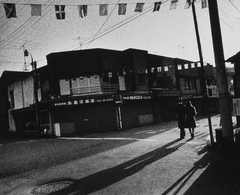
ISHIUCHI Miyako
“Yokosuka Story #30”
1976-77
gelatin silver print
45.6×55.9cm
ⓒ Ishiuchi Miyako
Outline
| Dates | December 9 (Sat.), 2017- March 4 (Sun.), 2018 |
|---|---|
| Open Hours | 10:00-18:00
*Open until 16:00 on March 1 (Thu.), 2018 *Open until 20:30 on March 3 (Sat.), 2018 *Admission until 30 minutes before closing. |
| Closed | Thursdays (except March 1, 2018), December 28, 2017- January 4, 2018. |
| Organized by | Yokohama Museum of Art [Yokohama Arts Foundation] |
Ticket
| Adults | 500(400) |
|---|---|
| University students
High school students | 300(240) |
| Junior high school students | 100(80) |
| Children under 12 | Free |
*( )= Group of 20 or more (pre-booking required)
*Free Admission for high school and younger student with valid ID on every Saturday.
*Visitors with disability and one person accompanying them are admitted free of charge.
(Please present a certificate at the entrance.)
*Collection gallery is available with a ticket of Special Exhibition.









